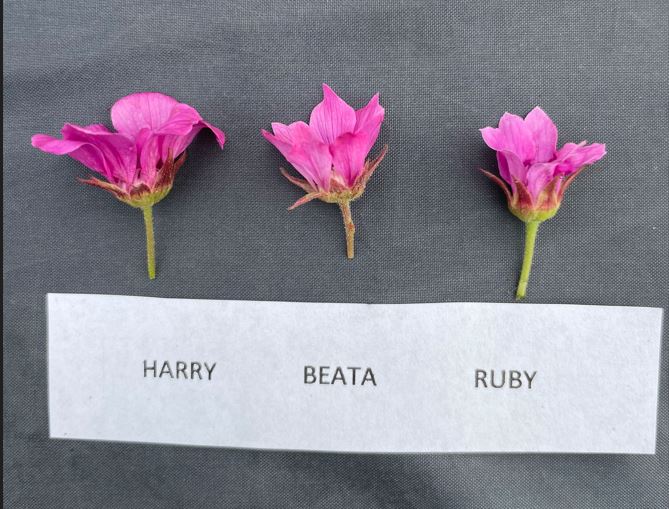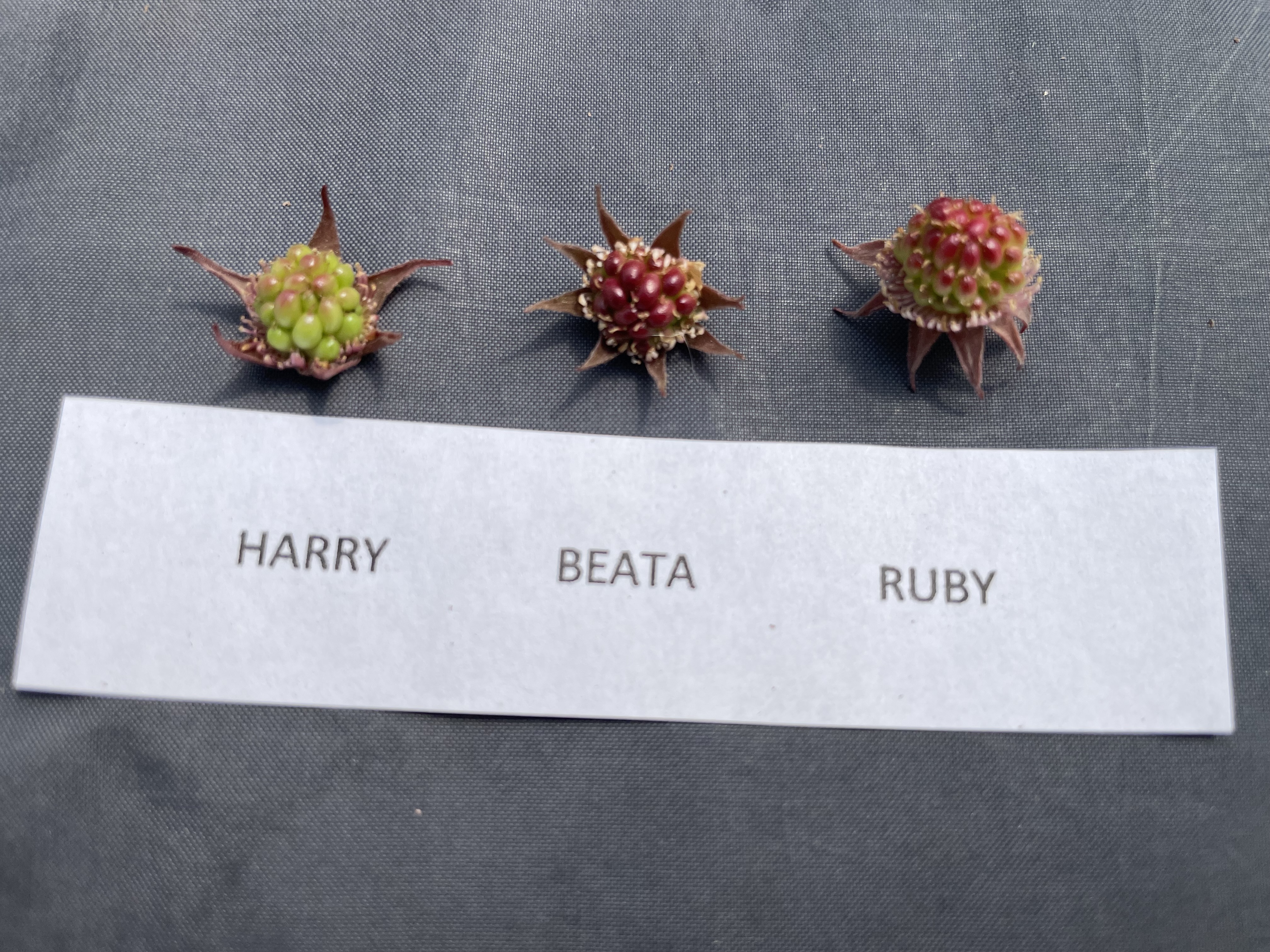Harry
| Denomination: | 'Harry' |
|---|---|
| Botanical Name: | Rubus arcticus |
| Applicant/Holder: |
Naess, S. Kristine 109 rue Labrie Pointe-aux-Outardes, Quebec G0H 1M0 Canada |
| Breeder: |
S. Kristine Naess, Pointe-aux-Outardes, Quebec |
| Application Date: | 2023-03-27 |
| Provisional Protection:: | 2023-03-27 |
| Application Number: | 23-11259 |
Variety Description
Varieties used for comparison: 'Ruby' and 'Beata'
Summary: The plants of 'Harry' have an upright growth habit and are shorter than those of 'Beata', which have a semi-upright growth habit. The anthocyanin colouration on the leaf of the young shoot of 'Harry' is of medium intensity whereas that of both reference varieties is of weak intensity. The upper side of the leaf of 'Harry' is medium green while that of both reference varieties is light green. The leaf of 'Harry' has weak rugosity while that of 'Beata' has medium rugosity. The upper side of the leaf of 'Harry' has absent or very sparse pubescence while that of 'Beata' has medium density pubescence. The terminal leaflet of 'Harry' is shorter than that of 'Ruby' and smaller than that of 'Beata'. The anthocyanin colouration on the peduncle of 'Harry' is of medium intensity whereas that of 'Ruby' is of weak intensity. The distribution of anthocyanin colouration on the calyx of 'Harry' is distinct whereas it is diffuse for 'Beata'. The presence of notched petals is absent or rare on the flower of 'Harry' while it is occasional on the flower of 'Ruby'. The fruiting period of 'Harry' begins mid-season and is of medium length while that of 'Beata' begins late and is short. At the time of fruit swelling, the anthocyanin colouration on the developing fruit of 'Harry' is sparsely distributed and of weak intensity whereas that of 'Beata' is generalized and of strong intensity. The fruit of 'Harry' is medium sized while that of 'Ruby' is large. The fruit skin of 'Harry' is dark red with medium glossiness whereas that of 'Ruby' is bright red with strong glossiness. The plants of 'Harry' senesce early while those of the reference varieties senesce mid-season.
Description:
PLANT: upright growth habit, senesces early
EXPANDING LEAF OF YOUNG SHOOT: medium intensity of anthocyanin colouration at anthesis
LEAF: concave in cross-section, weak rugosity, doubly crenate margin
LATERAL LEAFLETS: touching
LEAF (UPPER SIDE): medium green, absent or very sparse pubescence
TERMINAL LEAFLET: concave in cross-section
PEDUNCLE: medium intensity of anthocyanin colouration
FLOWERING: occurs early to mid-season
INFLORESCENCE: positioned above foliage
FLOWER: notched petals absent or rare
FRUITING PERIOD: begins mid-season, medium length
CALYX: medium intensity of anthocyanin colouration distributed in a distinct pattern
FRUIT: medium sized, weak intensity of anthocyanin colouration sparsely distributed at fruit swelling
FRUIT SURFACE: dark red, medium degree of glossiness
Origin & Breeding History: 'Harry' originated from a cross conducted in Pointe-aux-Outardes, Quebec in 2006 between a Rubus arcticus subspecies stellatus variety designated 'Beata' and a Rubus arcticus subspecies acaulis variety designated 'BS-1'. In 2007, the resulting seedlings were nursery matured in pots for 3 years before being planted into raised beds in 2010. Eight selections made in 2012, based on yield, fruit size, display and flavour, were propagated by rhizome cuttings and planted in replicated field trials in 2013 and 2014. The plants were evaluated from 2015 to 2018 in regards to fruiting period, yield, fruit size and flavour and from 2019 to 2021 in regards to clone compatability. Single stock plants of each of 6 retained selections, including the 2 parents, were successively divided and in 2021, controlled crosses on these plants were made to determine cross compatability between the selected clones. In August 2022, the final selection of the clone designated 'Harry' was based on flavour and cross compatability with two other selected clones.
Tests & Trials: The comparative trial for 'Harry' was conducted during the summer of 2023 in Pointe-aux-Outardes, Quebec. Individual plants in 10 cm pots were transplanted into 8 litre troughs in 2021, overwintered in a nursery and placed outdoors in the spring of 2023. The trial consisted of 10 blocks with each block consisting of 3 plants with the candidate variety distributed randomly either on the left or right of the 2 reference varieties. The blocks were arranged in 2 rows of 15 plants with a total of 10 plants per variety. All observations and plant height measurements were taken from 10 plants, or parts of plants. Leaf measurements were taken from 30 leaves. Mean differences were significant at the 5% confidence probability level based on a paired Student's t-test.
Comparison tables for 'Harry' with reference varieties 'Ruby' and 'Beata'
Plant height (cm)
| 'Harry' | 'Ruby' | 'Beata' | |
|---|---|---|---|
| mean | 12.0 | 12.3 | 17.7 |
| std. deviation | 1.8 | 3.3 | 1.8 |
Terminal leaflet length (cm)
| 'Harry' | 'Ruby' | 'Beata' | |
|---|---|---|---|
| mean | 2.60 | 2.93 | 3.42 |
| std. deviation | 0.36 | 0.45 | 0.47 |
Terminal leaflet width (cm)
| 'Harry' | 'Ruby' | 'Beata' | |
|---|---|---|---|
| mean | 2.20 | 2.13 | 2.63 |
| std. deviation | 0.43 | 0.37 | 0.47 |
Click on image for larger view

Arctic Bramble: 'Harry' (left) with reference varieties 'Beata' (centre) and 'Ruby' (right)
Click on image for larger view

Arctic Bramble: 'Harry' (left) with reference varieties 'Beata' (centre) and 'Ruby' (right)
Click on image for larger view

Arctic Bramble: 'Harry' (left) with reference varieties 'Beata' (centre) and 'Ruby' (right)
- Date modified: